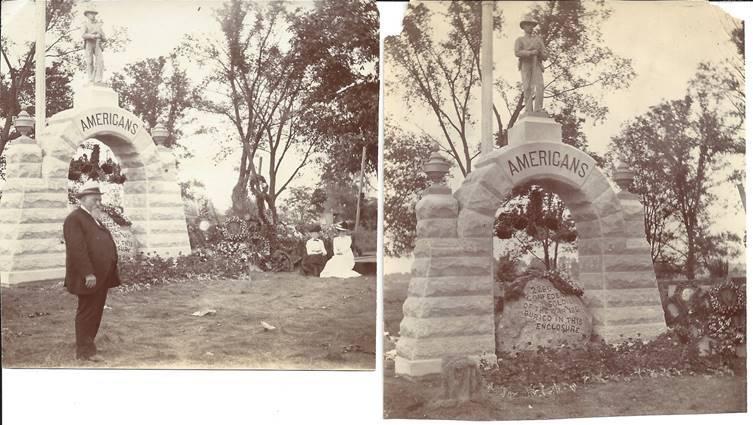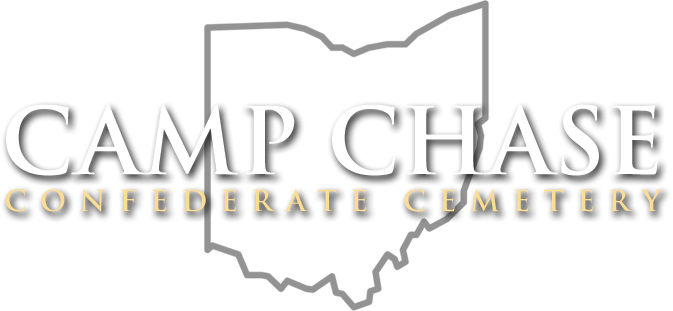616 Days: The Story About the Confederate Statue
William H. Knauss had been a private in Company G of the 2nd Regiment New Jersey Infantry and had been badly wounded in the face at the Battle of Fredericksburg, Virginia in December of 1862. Private Knauss was transferred to the Veterans Reserve Corps and shortly discharged from the Army as a private. He would later carry the honorary title of Colonel during his lifetime. While on business in 1868 in Maryland and Virginia Mr. Knauss encountered a former enemy who had lost his leg at the same Battle of Fredericksburg, Virginia. The two quickly became friends and promised each other they would look after graves of both Northern and Southern soldiers alike when they came across them. The Battle of Fredericksburg changed many lives including William H. Knauss nearby brush with death. Today many people including myself refer to the statue of the Confederate soldier at Camp Chase as “Fred” short for Fredericksburg.
The Federal government had purchased the cemetery in 1879. Arriving in Columbus, Ohio in 1893 Mr. Knauss was drawn toward the horrible condition of the Confederate graveyard known as the Camp Chase Cemetery. Just two years later the first Camp Chase Memorial was held and each year the crowds were a little larger.
Judge David F. Pugh formally of the 46th Ohio Infantry echoed some of the opinions made by Union veterans at the 1897 Camp Chase Memorial when he stated "Carrying two wounds made by Confederate bullets, I am perfectly willing that their graves may be decorated, and even to participate in it when their survivors are not numerous enough to do it. I am willing to admit that their heroism is part of our national heritage.”
By 1902 there were 45 States in America and well over a quarter of a million veteran Civil War soldiers living in the United States and some Confederate veterans had relocated to other locations in America including Columbus, Ohio such as Michael Spence and Newton Jasper Kidwell both of whom had worn Confederate gray and both had been with General Pickett and his famous charge at Gettysburg, Pennsylvania.
Clues are present in the photograph to help us establish a time period. The statue and arch were unveiled for the first time at the Camp Chase Cemetery on June 7, 1902 at the Camp Chase Memorial and the first tombstones were installed in the Spring of 1908 and are not present in the photograph thereby dating the photograph from 1902 to 1907. The gentleman in the photograph was known as Colonel William H. Knauss who is regarded as starting the Camp Chase Memorials beginning in 1895.
The last decade of the 19th century and the first decade of the 20th century saw a large number of Civil War monuments built. In the South memories of fallen loved ones took the form of stone and paid for by southern citizens. The arch and Confederate statue were made and paid by Northern citizens to symbolize peace between the North and South as the statue of the Confederate soldier faced southward toward home and dedicated by Governor Nash of Ohio at the 1902 Memorial.
The following are extracts from the Columbus Dispatch on April 13, 1902. “The arch which will be unveiled June 7 will be the first to be constructed by Northern people to mark the final resting places of Confederates who fought bravely for their convictions. It will be situated seventy-five feet from the entrance to the grounds, which fronts on Sullivan Avenue. Several years ago Colonel Knauss had a wooden arch placed over the bowlder and on it was painted “”Americans.”” “On top of the keystone of the arch is the statue of a Confederate private soldier in gray bronze. On each side of the arch there are large flower urns which set off the masonry in a very pleasing manner.”
During the early hours of August 22, 2017 vandals entered Federal property and toppled over a statue of a Confederate soldier from the arch. The soldier would remain off his post for 616 days. Shortly after the vandalism the Federal government employed 24/7 security for the Camp Chase Cemetery which is still in use. Additional security measures have also been implemented.
During the late morning hours of Tuesday April 30, 2019 “Fred” again took his post over the arch looking after the dead at the Camp Chase Cemetery.
(Photograph credit by Richard Hoffman)
The Federal government had purchased the cemetery in 1879. Arriving in Columbus, Ohio in 1893 Mr. Knauss was drawn toward the horrible condition of the Confederate graveyard known as the Camp Chase Cemetery. Just two years later the first Camp Chase Memorial was held and each year the crowds were a little larger.
Judge David F. Pugh formally of the 46th Ohio Infantry echoed some of the opinions made by Union veterans at the 1897 Camp Chase Memorial when he stated "Carrying two wounds made by Confederate bullets, I am perfectly willing that their graves may be decorated, and even to participate in it when their survivors are not numerous enough to do it. I am willing to admit that their heroism is part of our national heritage.”
By 1902 there were 45 States in America and well over a quarter of a million veteran Civil War soldiers living in the United States and some Confederate veterans had relocated to other locations in America including Columbus, Ohio such as Michael Spence and Newton Jasper Kidwell both of whom had worn Confederate gray and both had been with General Pickett and his famous charge at Gettysburg, Pennsylvania.
Clues are present in the photograph to help us establish a time period. The statue and arch were unveiled for the first time at the Camp Chase Cemetery on June 7, 1902 at the Camp Chase Memorial and the first tombstones were installed in the Spring of 1908 and are not present in the photograph thereby dating the photograph from 1902 to 1907. The gentleman in the photograph was known as Colonel William H. Knauss who is regarded as starting the Camp Chase Memorials beginning in 1895.
The last decade of the 19th century and the first decade of the 20th century saw a large number of Civil War monuments built. In the South memories of fallen loved ones took the form of stone and paid for by southern citizens. The arch and Confederate statue were made and paid by Northern citizens to symbolize peace between the North and South as the statue of the Confederate soldier faced southward toward home and dedicated by Governor Nash of Ohio at the 1902 Memorial.
The following are extracts from the Columbus Dispatch on April 13, 1902. “The arch which will be unveiled June 7 will be the first to be constructed by Northern people to mark the final resting places of Confederates who fought bravely for their convictions. It will be situated seventy-five feet from the entrance to the grounds, which fronts on Sullivan Avenue. Several years ago Colonel Knauss had a wooden arch placed over the bowlder and on it was painted “”Americans.”” “On top of the keystone of the arch is the statue of a Confederate private soldier in gray bronze. On each side of the arch there are large flower urns which set off the masonry in a very pleasing manner.”
During the early hours of August 22, 2017 vandals entered Federal property and toppled over a statue of a Confederate soldier from the arch. The soldier would remain off his post for 616 days. Shortly after the vandalism the Federal government employed 24/7 security for the Camp Chase Cemetery which is still in use. Additional security measures have also been implemented.
During the late morning hours of Tuesday April 30, 2019 “Fred” again took his post over the arch looking after the dead at the Camp Chase Cemetery.
(Photograph credit by Richard Hoffman)


